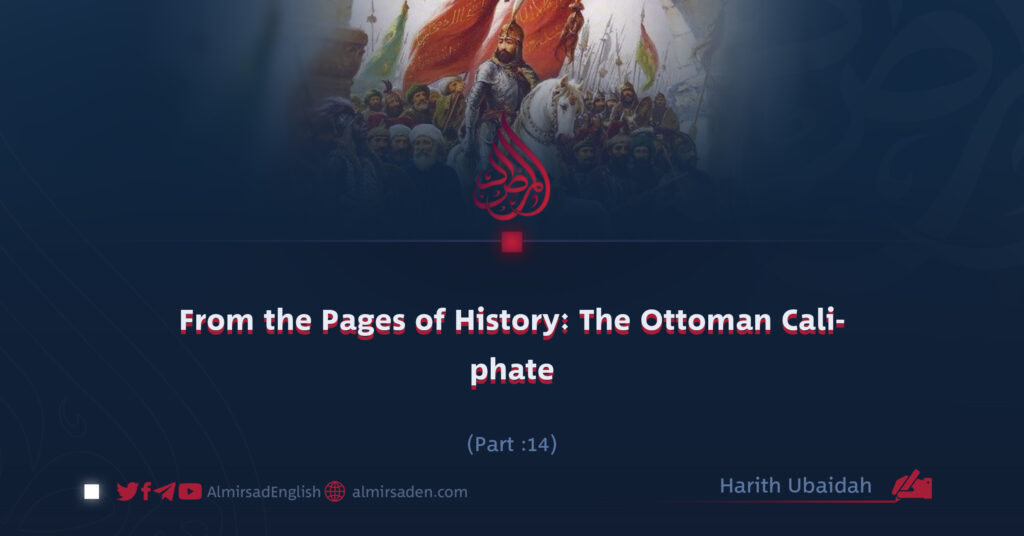Part 14
Author: Harith Ubaidah
The Formation of the Yeniçeri (Janissary) Army
When Sultan Orhan completed the organization of his newly structured army, he presented himself before a revered religious scholar renowned for his piety, righteousness, and deep spiritual insight. This saintly figure was Haji Bektash, who received the Sultan with great joy. Placing his hand upon the head of one of the soldiers, he supplicated:
“May Allah Almighty honor them, sharpen their spears and swords, and grant them victory in every battlefield they enter for His pleasure.”
Turning to Orhan, the scholar asked, “Have you named this army yet?”
The Sultan replied, “I have not yet considered a name.”
The scholar then declared, “Let it be known as ‘Yeniçeri’ (meaning ‘New Army’).”
The army’s banner was a red cloth bearing the image of a crescent moon with a sword beneath it, symbolically named Zulfiqar, in honor of the legendary sword of Imam Ali (may Allah be pleased with him). It was intended as a symbol of divine blessing, valor, and victory.
The Role of Alaeddin in Military Reform
Orhan’s brother, Alaeddin, a man of intellect, profound Sharia knowledge, and devout asceticism, played a crucial role in strengthening the newly established military force—particularly as conflicts with the Byzantines escalated and the burden of jihad intensified. He advised the Sultan to expand the army by enlisting young Turks and Byzantine converts to Islam who had demonstrated good character and strong commitment. These recruits were thoroughly trained in the principles of jihad and Islamic discipline.
Consequently, the number of Mujahideen in the Yeniçeri corps exceeded one thousand. Orhan and Alaeddin agreed that the purpose of this army was to consolidate the campaign against the Byzantines, facilitate the spread of Islam, train new Muslims in the path of jihad, and instill in them a deep appreciation for Islamic culture and zeal for serving the cause of Allah.
Refuting Slander and Orientalist Misconceptions
It is imperative to clarify that Sultan Orhan never forcibly separated Christian children from their families, nor did he compel anyone to embrace Islam. The claims made by certain Orientalist historians such as Carl Brockelmann and Herbert Gibbons are baseless and slanderous. These accusations must be critically examined and firmly refuted.
Academic integrity and Islamic fraternity demand that Muslim scholars, historians, researchers, educators, and media representatives fulfill their responsibility in exposing these falsehoods. The propagation of such distortions by Orientalist circles has unfortunately gained traction to the point of being accepted without scrutiny—despite being entirely unfounded.
Orhan’s Domestic and Foreign Policies
Throughout his reign, Sultan Orhan directed all military campaigns against the Byzantines. However, in 736 AH (1336 CE), the death of the ruler of the Karasi Emirate—a state that had arisen on the remnants of the Seljuk Sultanate of Rum—presented an opportunity. Following internal disputes among the deceased ruler’s heirs, Orhan annexed the emirate. This strategic move aligned with the Ottoman ambition to inherit the Seljuk legacy in Anatolia and establish authority over its former territories. This unification process continued during the reign of Sultan Mehmed the Conqueror until the Ottomans fully absorbed Anatolia.
To stabilize and strengthen the empire, Sultan Orhan undertook wide-ranging reforms. He fortified the newly acquired regions, constructed mosques, established centers of learning, and dispatched qualified scholars and administrators. These scholars were held in high esteem throughout the empire. Madrasas and educational institutions were founded in every major town, offering instruction in Arabic grammar, logic, rhetoric, jurisprudence, astronomy, geometry, and the physical sciences, alongside Quranic memorization, tafsir, hadith, and theology.
A Visionary Period of Consolidation
Following the annexation of the Karasi Emirate, Orhan chose not to pursue further conquests immediately. Instead, he focused for two decades on consolidating the state, organizing cities, and fortifying the military. During this period, he ensured internal peace, built extensive administrative structures, and invested in public infrastructure. His policies reflected remarkable foresight, piety, and strategic prudence.
Rather than engaging in constant warfare, Orhan prioritized stability and development. Every newly acquired region was integrated thoroughly—militarily, socially, and educationally—into the Ottoman realm. This approach made the Ottoman state a model of orderly governance and harmonious progress in Asia Minor.
Orhan’s efforts in administration and reconstruction significantly contributed to the cultural and civilizational revival of the Muslim world at the time. Once domestic peace had been secured, a new opportunity emerged due to internal strife within the Byzantine Empire. Emperor John Cantacuzenus sought Orhan’s assistance in a power struggle against a rival claimant. Seizing the moment, Orhan deployed his forces into Europe—thus extending Ottoman influence beyond Anatolia.
The Entry into Europe and the Fall of Gallipoli
In 1358 CE, a devastating earthquake struck the Thracian city of Gallipoli, collapsing its defensive walls and forcing the inhabitants to flee. The Ottomans quickly moved in and occupied the city. Despite vehement protests from the Byzantine Emperor, Orhan responded, “By divine grace, the gates of the city have opened to us,” and Gallipoli became the first permanent Ottoman foothold in Europe.
It was from Gallipoli that the initial military incursions into the Balkans were launched. When John V Palaiologos became the sole ruler of Byzantium, he surrendered much of the region to Sultan Orhan in exchange for grain shipments to Constantinople. Orhan, in turn, dispatched numerous Muslim tribes to the Balkans to propagate Islam, ensuring that Christian forces would find it increasingly difficult to expel the Ottomans from European soil.
